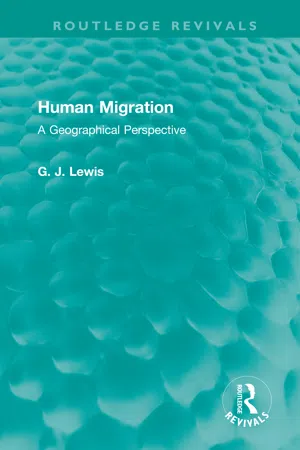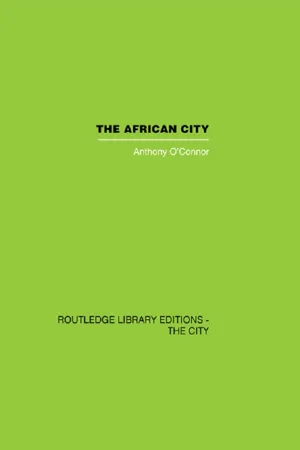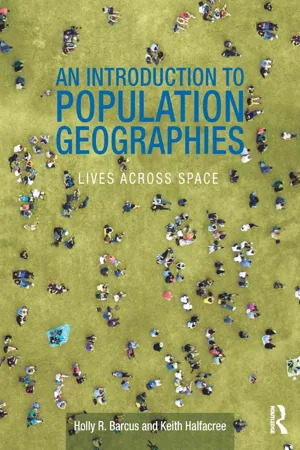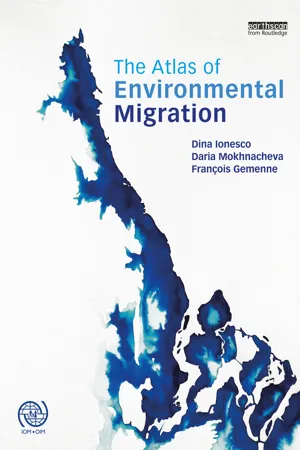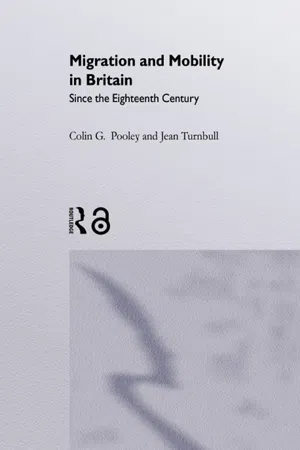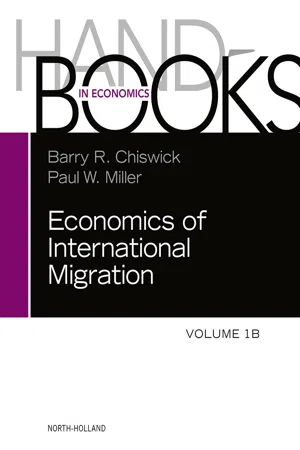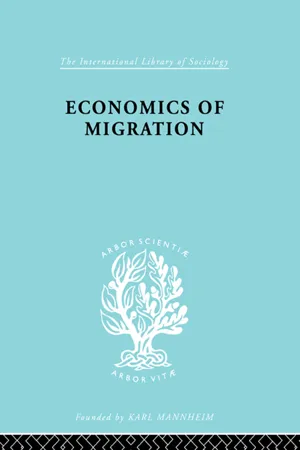Geography
Consequences of Migration
The consequences of migration refer to the effects of people moving from one place to another. These consequences can include economic impacts, such as changes in labor markets and remittances, as well as social and cultural impacts, such as changes in demographics and the spread of ideas and customs. Additionally, migration can also have environmental consequences, such as changes in land use and resource consumption.
Written by Perlego with AI-assistance
Related key terms
Related key terms
1 of 4
Related key terms
1 of 3
12 Key excerpts on "Consequences of Migration"
- eBook - ePub
People on the Move
Studies on Internal Migration
- Leszek Kosi?ski, R.M. Prothero(Authors)
- 2023(Publication Date)
- Routledge(Publisher)
Termote 1967 ).Consequences of Migration
This aspect of migration study has the greatest appeal to scholars oriented towards application of their research and to politicians responsible for making decisions affecting migrations (UN 1953 ). There is no doubt that migration affects the society at origin, at destination, and migrants themselves (Mangalam 1968 ). The consequences can be observed and measured in economic, social, cultural, political and demographic terms. The researcher may try to predict as objectively and accurately as possible the likely Consequences of Migration so that politicians and planners can take decisions in full knowledge of what can be expected. One version of such policy-orientated research is the prediction of a future redistribution of population resulting from the unaltered continuation of present trends (Rogers 1966 ; Compton 1968 ). Another aspect of studies on Consequences of Migrations deals with assimilation of migrants (Eisenstadt 1953 ). Successful assimilation of a migrant can be said to represent the final stage of the process (Mabogunje 1970 ). Here the distinction between spatial and social aspects of moving becomes blurred and there is more involvement in the study of the sociological aspects of migration.Conclusion
It is impossible within limited space to more than touch upon some of the major aspects of migration study. Discussion has inevitably been restricted and selective for the literature on migration is diverse and voluminous. Nonetheless, of the major components in population change migration is the one to which the least attention has been given. It is the most difficult component to conceptualize, measure and analyse. Some of the basic concepts and problems of measurement are considered in the papers which follow. They are both descriptive and analytical in their approach to the study of migration. - eBook - ePub
Human Migration
A Geographical Perspective
- Gareth J. Lewis(Author)
- 2021(Publication Date)
- Routledge(Publisher)
10
Consequences of Migration
DOI: 10.4324/9781003183051-10Although the preceding discussion has been concerned with the nature of migration as a response to social, political, economic and cultural changes within society, it is quite clear that migration can also be viewed as an independant variable, since it can initiate change itself (Figure 10.1 ). In other words, given a pattern of geographical mobility, what social, political, economic and cultural consequences ensue? However, it should be borne in mind that migration is only one of many agents which can initiate change. Among others which are of considerable significance are the dissemination of new ideas, information and techniques by means of spatial diffusion (Hägerstrand, 1967; Lewis, 1979b).Figure 10.1: A Simplified Representation of the Relationship between Selective Immigration and Changes in Britain’s Social Structure within a Time Perspective Source: Based on Kendall, 1977, 8-10.It is generally assumed that migration has a beneficial effect on economic development (Gaude and Peek, 1970). Such an assessment is based upon economic criteria, and, despite considerable research, the non-economic Consequences of Migration have too often been overlooked. This is rather surprising, when it is recalled that the greater part of this research has emphasized that migrants tend to experience considerable problems of adjustment and conflict as well as personal and community disorganization (Rose, 1969). Clearly, before a meaningful assessment can be made of the benefits of migration its effect upon those societies and individuals involved need to be discussed. Such a theme therefore necessitates a detailed examination in its own right.Mabogunje (1970), in his systems approach to the migration process, suggested that when an individual leaves the countryside for the town, the former has to adjust to the loss of a member and the latter to an addition (Figure 2.10 ). At the same time the individual himself has to adjust to a new way of life, and his experiences when fed back to the countryside become the basis of accelerating or dampening down further movement. When viewed in these terms migration has an effect on many aspects of human activity and at several geographical scales. These interrelationships can be represented in a simplified framework (Table 10.1 - eBook - ePub
- Anthony O'Connor(Author)
- 2013(Publication Date)
- Routledge(Publisher)
As far as the social life of African city dwellers is concerned household structures may be even more significant than age structures, and some information on this is provided in various recent surveys and censuses. It is clear that single-person households are much more common in some cities than in others, while the extent to which larger households include non-relatives also varies. This topic is taken up below in case studies which bring together various aspects of migration and population structure for particular cities.Other Consequences of Migration
While some consequences of massive rural–urban migration are perfectly obvious, others are matters of intense dispute, producing diverse attitudes towards it among academics and within African governments. The academic literature has increasingly stressed its negative consequences (e.g. Amin 1974, Gregory 1974, Gugler and Flanagan 1977, 1978, Van Binsbergen 1978, Riddell 1978, 1981).The impact on the cities in terms of accelerated population growth and resulting desperate need for extra housing, schools, water and so on, is not too hard to assess. The effects of the extra labour on the urban economy are more complex. The influx is significant through increased consumption as well as a very uncertain amount of increased production, while it affects the balance between larger- and smaller-scale activities and the level of earnings within each.Since such migration shows every sign of continuing, we must surely assume that it is proving beneficial to many of those who move – from their own viewpoint: and fortunately most of those for whom it does not work out well can return to their home areas having gained experience and lost very little. Few assumptions can be made, however, about the consequences for the existing urban population. Most city dwellers are glad to welcome their own kinsfolk, as long as they do not expect free hospitality for too many months, but many reckon that the total flow is too great in view of the competition it creates for jobs, housing and school places. One possibility is that additional in-migration tends to benefit the rich businessmen by increasing markets, lowering wages and raising rents, while harming the poor.The consequences for the cities are not only economic. The migrants bring with them ideas and attitudes that may differ from those of many existing urban dwellers. They may alter the balance among ethnic groups, and influence patterns of language use. Where overt political activity is permitted they are bound to influence that also. In view of all this, it is surprising how few studies have been explicitly directed to the (real and imagined) impact of continuing in-migration on the people already in the cities, especially as this must greatly influence urban-based policy makers. - eBook - ePub
Migration Theory
Talking across Disciplines
- Caroline B. Brettell, James F. Hollifield(Authors)
- 2022(Publication Date)
- Routledge(Publisher)
Geography is a discipline closely associated with maps and spatial reasoning. Maps, especially thematic ones, challenge us to visualize spatial distribution of phenomena across space and over time at various scales. Anything that is unevenly distributed is eminently mappable and thinking in maps invites us to consider spatial arrangements. The varied movement of people has been an irresistible subject for geographical inquiry and theorization since the inception of the modern discipline. Why is a cluster of migrants located in one place and not another? How are clusters linked through networks and how do these distributions influence space and place? What structural or environmental forces are driving human mobility? Mapping forces one to select a scale of analysis; consequently, geographers have a proclivity to shift scales, from the local to the global, and even jump scale when necessary. Not limited to any single container of convenience, such as the territorial state, geographers consider various socio-legal containers when theorizing about migration from neighborhoods, to cities, to meta-regions such as Europe or Africa. Geographic scholarship is increasingly interested in how these containers are enforced, deformed, and reconstituted in response to migration. Finally, geography is concerned with a deeper understanding of context and placemaking, seeing space as layered with information such as: the physical environment, the ethnic composition of residents, and their socioeconomic well-being. Human mobility is often a response to and a catalyst for these layers, and thus the social and environmental contexts of areas of departure and reception invite geographical theorization.This chapter will consider some of the foundational theories that shape geographical understandings of migration and human mobility. It argues that, as a discipline, geography has a long-standing thematic interest in human migration, because the movement of people “continually disrupts and remakes geography, as spatial linkages and interconnections both form and dissolve when people move” (Skop 2019: 108). As international migration has intensified since the 1990s, geographic scholarship that empirically demonstrates these flows and theorizes their impact has steadily increased (Price and Benton-Short 2008; King 2012; Czaika and de Haas 2014; Winders 2014; Yeoh and Ramdas 2014; Ehrkamp 2017, 2019, 2020; Collins 2020). Theoretically, geographers have worked across disciplines, and have modified existing theories, as well as inserted innovative theoretical perspectives and methodological approaches. At the core of much of this work is a profound interest in explaining spatial patterns and human networks, as well as a sensitivity to scalar shifts and bordering practices. Human geographers offer theoretical insights about the migrant experience, limits to human mobility, practices of placemaking, development, and integration, as well as the intersectionality of gender, race, and class in understanding migration (Silvey and Lawson 1999; Carling 2002; van Riemsdijk 2014; Yeoh and Lam 2016). Because of geography’s inclination to examine the relationship between society and environment, there is also a growing research interest in the environmental drivers of migration, especially connected to climate change (Hugo 1996; Piguet 2010; Piguet, Kaenzig, and Guélat 2018; Jockish et al. 2019).Within the sub-disciplines of geography, population geographers have an obvious interest in migration. The International Journal of Population Geography, later renamed Population, Space, and Place - eBook - ePub
- Adrian Bailey(Author)
- 2014(Publication Date)
- Routledge(Publisher)
The remainder of this chapter explores how research activities reflected the three positions of continuity, pluralism and critical engagement. While by no means exhaustive, the following review attempts to capture something of the balance of contemporary scholarship in the field. It identifies four poles of research activity. The first of these concerns ‘movement’ and focuses on descriptions and explanations of human mobility. The increasingly diverse and complex array of mobility at all scales attracted both public and research interest during this period. The second research pole describes geographic work on natural increase and decrease, focusing on fertility and mortality and morbidity. Also strongly influenced by stable population theory, work on the third research pole explores geographies of population compositions. The final research pole concerns ‘non-demographic’ consequences and evidences a shift from livelihood-focused studies to more general research on the social, cultural and economic dimensions of population change. For each research pole, representative studies illustrate how those adopting continuity, pluralist and critical positions contributed substantive knowledge. The chapter concludes by considering how reconcilable these positions might be.Movement
Discussions of movement, broadly defined, dominated the field’s research output during the 1980s and 1990s. When the Geography in America collection appeared, five of the six themes in the commissioned chapter on population geography featured movement (Gaile and Willmot 1989 - eBook - ePub
An Introduction to Population Geographies
Lives Across Space
- Holly R. Barcus, Keith Halfacree(Authors)
- 2017(Publication Date)
- Routledge(Publisher)
CHAPTER 5Placing human migration5.1 INTRODUCTION: DEFINING MIGRATION
5.1.1 What is migration?
Migration remains the most widely studied and examined element within Population Geography (Boyle 2003, 2004). Moreover, whilst Geographers have played a pivotal role in shaping our contemporary understanding of it, the topic is of interest to numerous academic disciplines, including Demography, Sociology, Political Science, Economics and Anthropology (Brettell and Hollifield 2008a). In this respect, approaching migration as it occurs within the life course has considerable potential for bringing together a scattered body of scholarship often fragmented by “disciplinary partitioning” (Olwig and Sørensen 2002: 7).But what exactly is migration? Initially put, as in a recent textbook, it is “the movement of people to live in a different place” (Holdsworth et al. 2013: 96) or a “permanent change in residence.” It is residential relocation. Or, as expressed in UK and US censuses, a migration is deemed to have occurred when one’s “usual address” has changed within the last 1 or 5 years, respectively (ONS 2013; USCB 2013). Simple, then, one might think! However, as Holdsworth et al. (2013: 98) also noted, careful consideration of these definitions immediately raises a host of questions: what precisely is meant by “different place,” “live in,” “permanent,” or “usual address”? Consequently, by the end of the present chapter, “migration” will have been demonstrated to be at least as complex and multi-dimensional a concept as Chapter 4 revealed “fertility” to be.Starting with the idea of “different place,” the type of areal unit(s) involved in a migration is an initial important consideration when defining it specifically. A crucial starting point is whether a political boundary is crossed during a move. For example, an individual could move from one county to another within the same US state or from one state to another. Both moves are conventionally described as intra-national or internal migration, because neither involves leaving the US. In contrast, a move from the US to Canada, crossing an international border, is an international migration - eBook - ePub
- Dina Ionesco, Daria Mokhnacheva, François Gemenne(Authors)
- 2016(Publication Date)
- Routledge(Publisher)
The increasing incidence of some of these environmental threats is attributable to the very progress humanity has accomplished since the Industrial Revolution, Climate change constitutes one of the greatest challenges humanity will have to face, as it calls into question the economic and lifestyle choices our society has made, by threatening our very survival as a species. We have no other choice but to try to reduce our impact on the environment, and to adapt to some of the irreversible changes we have caused, or face increasing social and economic costs and damage. Migration will inevitably be part of this picture, either as a social and human cost of inaction or restrictive policies, or as a positive strategy to reduce risks and people's vulnerability, if we make the right political and economic choices. Good migration management can be part of the solution, together with sound environmental and sustainable development policies.Part 2 of the Atlas delves into the complex interaction between environmental phenomena, human society and migration, presents various sudden-onset events and slow-onset processes, natural or human-made, which affect the planet's population, and looks into the mechanisms through which environmental factors affect human mobility. A special focus is placed on climate change, the effects of which are often poorly discerned from other environmental phenomena. Environmental migration is then discussed within the wider context of the traditional drivers of migration.Understanding environmental hazards
Our planet is a very complex system of interrelated natural geophysical, meteorological and climatological processes, which are associated with sudden, rapidly occurring natural events, as well as with long-term slowly developing processes of environmental change. The face of the planet keeps changing: the continuous movement of tectonic plates modifies the shape of the continents, builds new mountains and volcanoes, and forms fault lines. These internal geological processes provoke sudden-onset events such as earthquakes, volcanic eruptions, tsunamis, landslides or avalanches, causing widespread damage to cities and infrastructure, and often resulting in great human losses. - Colin Pooley, Jean Turnbull(Authors)
- 2005(Publication Date)
- Routledge(Publisher)
The central question to be addressed in this chapter can be put very simply: did migration matter? This question can be explored by focusing on the impact on individual people and their families, on the places that migrants left and went to, and on change within the wider structures of economy and society. The main difficulty in examining links between migration and social and economic change at either the individual or societal level relates to the issue of causation. The fact that migration was occurring at a time of economic change in a particular region, or of turmoil in the lives of individual migrants, does not mean that the events were necessarily related. Even if there was a relationship the nature of causation is not always clear. For instance, was migration a response to forces of change operating within society as a whole, or was the process of migration itself an agent of change? Did an individual move because of major difficulties or changes in their circumstances, or did the act of migration itself create new problems and fundamentally change people’s lives?There are, of course, no simple answers to such questions, and in many instances a whole host of causes and effects will have been closely interrelated. Disentangling these for the more distant past may be an impossible task. The aim of this chapter is to use both the longitudinal migration data and evidence from diaries and life histories provided by family historians to begin to explore some of the impacts of migration on individuals, places and wider society. This is achieved by, first, examining the impacts of short distance and long distance mobility, suggesting that the impacts of these events would have been rather different. Second, the impact of migration on places is assessed by reviewing evidence from the aggregate data set for links between migration and processes of local and regional change. Third, the extent to which the meaning of migration, and its links to other processes of change, varied over time is explored by focusing on four cohorts of migrants with similar characteristics to examine the extent to which parallel processes were operating at different periods of time. It is obvious that historical events assume much greater significance if they had an impact on and meaning for the people involved, and if they were related to the broader processes of change that were taking place within society. Because of the volume of migration in the past, and its potentially disruptive effects in moving people from one part of the country to another, it is usually assumed that migration had such significance. This chapter explores this proposition in detail drawing on evidence provided by family historians.- eBook - ePub
Britain's Population
Demographic Issues in Contemporary Society
- Steven Jackson(Author)
- 2013(Publication Date)
- Routledge(Publisher)
6MIGRATION AND THE GEOGRAPHY OF POPULATION
The patterns of population change in any given area are determined by the combined effects of prevailing trends in fertility, mortality and migration. As noted, Britain’s population in the 1990s is relatively stable, with little inherent potential for natural growth in the foreseeable future and a probable long-term decline. However, a stable national regime masks the importance of more volatile patterns of change within individual localities. Patterns of fertility and mortality vary from place to place in relation to population structure and local economic performance, but the principal influence on local patterns of change is the movement of population. Some areas of Britain have lost significant numbers over the past twenty years, particularly the inner areas of the major metropolitan centres. Other localities have grown substantially as a result of a sustained influx of migrants. The movement of population not only influences the distribution of total numbers but also impacts on local variations in fertility and mortality. Migration flows tend to be selective in terms of age and social status. The influx to. the expanding centres in the South East tends to be characterized by young, skilled or professional adults with the effect of creating a bulge in the age/sex structure and a rise in underlying trends in fertility. The stream of retirement migrants to the English coastal resorts has the reverse effect, adding to the levels of mortality in the receiving communities.Patterns of population movement occur at different levels and at different scales. In Britain the dominant flows are the general drift of population from the industrial districts of the North and West towards the metropolitan economy in the South and East, and the outflow from the larger towns and metropolitan centres towards suburban and rural districts. This latter stream of movement is commonly referred to as ‘counterurbanization’ and reflects a sustained pattern of population redistribution that has been effective at varying rates throughout the twentieth century. At a more local level there is a constant ebb and flow of movement over short distances as a consequence of residential relocation. In this chapter the complex patterns of population movement, reflecting both dimensions of time and space, will be considered at a number of different scales: international migration, inter-regional movements, intra-regional shifts and local mobility. - eBook - ePub
- Barry Chiswick, Paul W. Miller(Authors)
- 2014(Publication Date)
- North Holland(Publisher)
Acemoglu and Robinson, 2012 ) has further enhanced our understanding of economic growth. This chapter focuses on the impact of a change in population through international migration on short-run and long-run economic growth. We shall see that this impact is complex and wide ranging. We therefore consider the impact of foreign migration on the rate of economic growth of countries or regions from a range of perspectives.Cross-country labor migration has become a major international trend in recent decades. Settlement abroad remains highly restricted, in absolute terms but also relative to trade and capital mobility. Nonetheless, migrants account for more than 10% of population in many developed countries and for a quarter or more in some. Migrants are in many cases economic “opportunity seekers” whose spatial choice behavior is determined by more favorable economic conditions in destination areas or countries than “at home”. Thus, it is plausible that both richer countries and faster-growing countries attract more migrants. But once such countries have become a destination for flows of foreign migrants, the socio-economic impacts of these migrants on host regions or countries become important issues. The systematic assessment of these impacts is called migration impact assessment (MIA; see Nijkamp et al., 2012 ).MIA contains various impact categories, many of which may have implications for levels and growth of real income per capita. These categories include: labor market impacts (e.g., wages, jobs, unemployment); innovation (e.g., patents, product innovations, process innovations); international economic relations (e.g., international trade, tourism, foreign direct investment); entrepreneurship (e.g., ethnic firms, ethnic precincts, competition); social impacts (e.g., trust, cohesion, segregation) and population composition (e.g., cultural diversity, socio-economic diversity). These and other MIA categories have attracted much attention in recent years and various methodological perspectives can be found in the literature (Nijkamp et al., 2012 - eBook - ePub
- Julius Issac(Author)
- 2013(Publication Date)
- Routledge(Publisher)
Chapter VI The Effect of Migration The broad conclusions we arrived at in the two previous chapters as to the usefulness of migration for both the immigration and emigration countries need further elaboration in two respects: (1) When discussing the optimum theory of population and the economics of population decline, we found that the purely numerical aspect of the migration problem is of primary importance from the economic viewpoint only under certain conditions. Broadly speaking it could be presumed that unrestricted and unselected immigration into sparsely populated countries with abundant natural resources was likely to yield increasing returns. The application of the law of diminishing returns was seen to be legitimate in the case of unrestricted and unselected emigration from densely populated agricultural areas at a low stage of capitalistic production. Though this law is essentially concerned with variations of homogeneous factors, the fact that migration consists in movements of non-homogeneous populations could in these cases be neglected, as the qualitative differences are of minor importance compared with the economic effect of the changes in population size. We have also seen, however, that the usefulness of migration to countries with highly developed capitalistic production and with a declining rate of population growth is largely determined by the quality of the additional population, and therefore that a crude extension of the law of diminishing returns would then be fallacious. But it has so far been assumed that migration would result in an increase or decrease in numbers of the populations concerned equal to the number of migrants - eBook - ePub
- Cecilia Tacoli(Author)
- 2018(Publication Date)
- Routledge(Publisher)
accumulative migration (Deshingkar and Start, 2003) has been gaining acceptance. Rao’s (2001) study of Andhra Pradesh distinguishes between migration for survival and migration for additional income. He observes that people from Rayadurga district were migrating for survival in the 1970s but changed to migration for additional income in the 1990s. Another example is Bihar where earlier studies described distress migration and more recent ones such as the one by Karan (2003) describe migration in much more positive terms. In the PPAs synthesized in Voices of the Poor (Narayan et al, 2000) migration was identified by both men and women as an important factor leading to upward mobility: the importance of migration was greatest in Asia, followed by Latin America and the Caribbean and less so in Africa.When migration is bad for WSDA reverse relationship between migration and watershed development has also been shown to exist where migration adversely affects the incentives for community resource management and participation. Concern has also been expressed in the past over the potentially detrimental effects of out-migration on the productivity of sending areas due to the depletion of labour. While some studies have certainly shown a worsening of pov-erty levels due to the large-scale male dominated migration as in remote areas of Nepal and Africa, more recent research has shown that some of these impacts may be offset in situations where wages in the destination are high and remittance and communication mechanisms are improving as in several parts of India, Southeast Asia and China.An important implication of livelihood diversification is that natural resource-based activities may become part-time and this could have negative consequences particularly for participatory resource management such as watershed and community forestry pro-grammes. Those who are away for long periods of time may not be able to participate in community activities and decision making and their access to resources may be compro-mised. Adverse effects of migration on watershed development have been documented by Turton (2000) and Samuha in Karnataka. Also, in a recent conference on common property resource management,8
Index pages curate the most relevant extracts from our library of academic textbooks. They’ve been created using an in-house natural language model (NLM), each adding context and meaning to key research topics.
Explore more topic indexes
Explore more topic indexes
1 of 6
Explore more topic indexes
1 of 4

